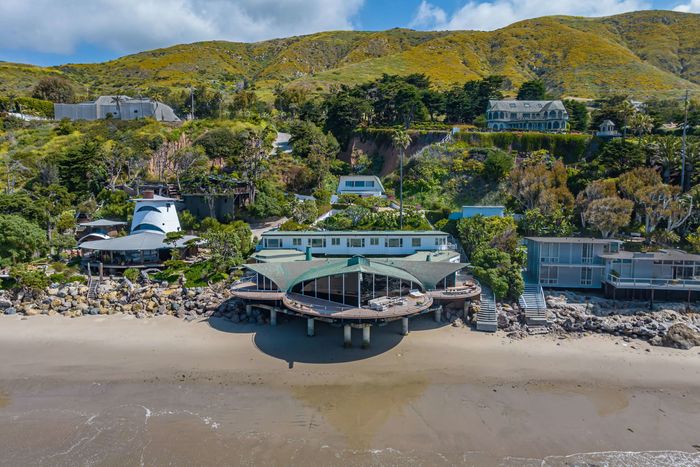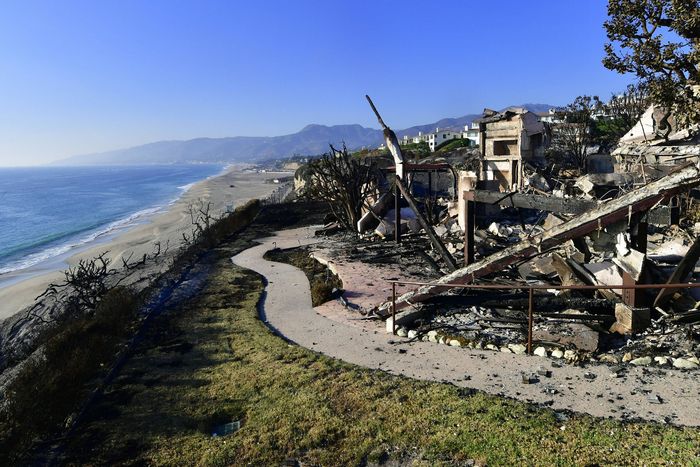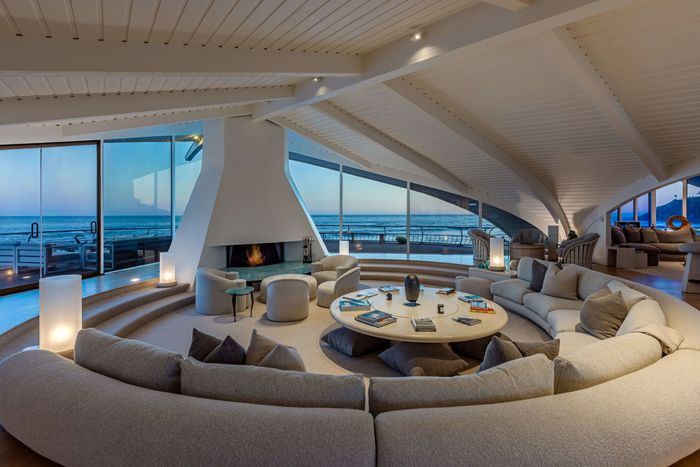The Kushner-Klosses Buy a Precarious Malibu Landmark

The 1957 Wave House has been updated over the years to face the reality of rising seas. A listing photo shows the reinforced concrete columns, added later.
Photo: Carolwood Estates
In the 1950s, the architect Harry Gesner wanted to get a sense of the rocky coastal site in Malibu where his clients planned to build. So he picked up a surfboard, paddled out past the breakers, and turned around. “I wanted a shape like you’d find in the ocean,” he told Curbed in 2016. Sketching on the nose of his surfboard with a grease pencil, he imagined a design that both echoed the sea and literally perched over the water at high tide.
Joshua Kushner and Karlie Kloss in July this year, stepping out of Jeff Bezos’ housewarming party.
Photo: Gotham/Getty/GC Images
Gesner died in 2022, and the 1957 Wave House is now his most famous work, an icon of California’s iconoclastic modernism, an inspiration for the Sydney Opera House, and a landmark recognizable to locals who spot it as they drive the Pacific Coast Highway. It sold this week for $29.5 million to Karlie Kloss and Joshua Kushner — news that broke in The Wall Street Journal, which reported that the very tall, very connected billionaires bought after a major price cut: a $20 million drop they might have been able to negotiate because buyers in Malibu are looking away from the beach, toward homes that are less likely to be sucked into the sea.
The Wave House is balanced on an eroding beach and faces a rising sea — it’s officially stuck in both a “Tsunami inundation zone” and a FEMA flood zone (given a 26 percent chance of flooding over the life of a 30-year mortgage, according to numbers that are already outdated because of the speed of rising seas). The Kushner-Klosses also own a $23.5 million mansion on the water in Miami, which constitutes either an exercise in optimism or a future tax write-off. And even that house might outlive this one.
A listing photo shows how the house noses out over the beach even farther than its neighbors. Gesner wanted the house to have a relationship with the sea and be inundated at high tide.
Photo: Carolwood Estates
But the most pressing danger might be fire. The Malibu house is in the state’s highest severity zone, glowing stark red on fire maps. The wildfires of 2007 came close, and the 2018 Woolsey Fire — the one that killed three people as it burned 90,000 acres, sucked down by wind from the hills and around the address — came much closer. The Wave House and a thin mile-long strip of neighbors on the beachfront might have escaped thanks only to a quirk in the conditions.
Damage from the 2018 Woolsey fire in Point Dume, a 15-minute drive from the Wave House.
Photo: Frederic J. Brown/AFP/Getty
Former owners, including Rod Stewart and record executive Mo Ostin, have shored it up, reinforcing the concrete piers that pin the house to a rocky precipice. (This is, after all, California, where earthquakes are a risk along with fire and flood.) Kushner and Kloss might see themselves as ideal stewards who can pour literal tens of millions into the home’s preservation.
Gesner seemed to know that some of his houses were doomed. He was an environmentalist who spoke against the use of fossil fuels and upgraded his Mercedes-Benz to run on electricity. Ten years before his death, he described his current obsession as so-called “survival houses,” meant to withstand “the worst elements.” Yet Gesner, who lived next door in an even-more-wonderful beachfront mansion, wasn’t a worrier. Lisa Germany, who interviewed him dozens of times for her book about his work, remembered how his coastal houses “did not hunker down,” she said. “They rose up and faced the sea with the same sort of tone the sea had. They were bold that way.”
A listing photo shows how a roofline that resembles lapping waves gives the interiors the shape of an overturned canoe. The original home had exposed wood and stone, which was painted a coastal white by a later owner.
Photo: Carolwood Estates
Source link








